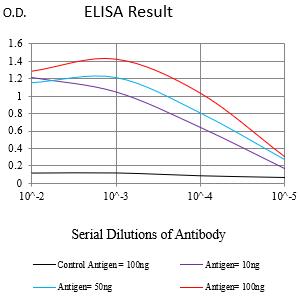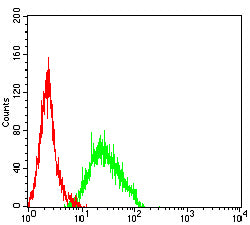

| WB | 咨询技术 | Human,Mouse,Rat |
| IF | 咨询技术 | Human,Mouse,Rat |
| IHC | 咨询技术 | Human,Mouse,Rat |
| ICC | 技术咨询 | Human,Mouse,Rat |
| FCM | 1/200 - 1/400 | Human,Mouse,Rat |
| Elisa | 1/10000 | Human,Mouse,Rat |
| Aliases | P1; SI; SIL; ME20; P100; SILV; ME20M; gp100; ME20-M; PMEL17; D12S53E |
| Entrez GeneID | 6490 |
| clone | 5C6G8 |
| WB Predicted band size | 70.2kDa |
| Host/Isotype | Mouse IgG1 |
| Antibody Type | Primary antibody |
| Storage | Store at 4°C short term. Aliquot and store at -20°C long term. Avoid freeze/thaw cycles. |
| Species Reactivity | Human |
| Immunogen | Purified recombinant fragment of human PMEL (AA: 25-192) expressed in E. Coli. |
| Formulation | Purified antibody in PBS with 0.05% sodium azide |
+ +
以下是关于PMEL抗体的3篇参考文献及其摘要概述:
---
1. **文献名称**: *Monoclonal antibody HMB-45 identifies the melanosomal glycoprotein gp100 in melanomas and metastatic melanocytes*
**作者**: Wick, M. R., et al.
**摘要**: 该研究验证了HMB-45单克隆抗体特异性识别PMEL/gp100蛋白的能力,并证明其在黑色素瘤病理诊断中的应用价值,尤其在区分转移性黑色素细胞肿瘤与其他恶性肿瘤中的作用。
2. **文献名称**: *The Silver locus product Pmel17/gp100 is required for melanosome biogenesis*
**作者**: Theos, A. C., et al.
**摘要**: 通过基因敲除和抗体标记实验,揭示了PMEL蛋白(gp100)在黑色素体形成中的关键作用,证明其参与黑色素合成与细胞器结构的成熟过程。
3. **文献名称**: *PMEL17 expression is dispensable for melanoblast survival in mice*
**作者**: Chi, J., et al.
**摘要**: 利用PMEL抗体在小鼠模型中研究黑色素细胞发育,发现PMEL蛋白对黑色素母细胞存活非必需,但影响成熟黑色素细胞的功能与色素沉积。
---
**备注**:HMB-45是实验室中常用的抗PMEL抗体,常用于临床病理诊断(如黑色素瘤检测)。如需扩展,可进一步检索涉及PMEL抗体在免疫治疗或疾病机制中的研究。
PMEL antibodies target the premelanosome protein (PMEL), a key glycoprotein involved in melanin synthesis and melanosome biogenesis. PMEL, also known as Pmel17 or SILV, is predominantly expressed in melanocytes and retinal pigment epithelial cells. It plays a critical role in forming the fibrillar matrix of melanosomes, the organelles responsible for pigment production and storage. These fibrils provide a scaffold for melanin deposition, ensuring efficient pigment synthesis and distribution in skin, hair, and eyes.
Structurally, PMEL consists of multiple functional domains, including a N-terminal region for trafficking, a PKD domain for fibril formation, and a C-terminal region involved in proteolytic processing. Its maturation involves sequential cleavage by proprotein convertases and γ-secretase, generating fragments that self-assemble into amyloid-like fibrils. This unique amyloidogenic property is non-pathogenic and essential for melanosome function.
PMEL antibodies are widely used in melanoma research, as PMEL overexpression is linked to melanoma progression. They aid in studying melanocyte development, pigmentation disorders (e.g., albinism), and melanoma biomarker discovery. Common applications include immunohistochemistry, Western blotting, and flow cytometry to track melanosome dynamics, melanocyte differentiation, or tumor-specific PMEL isoforms. Additionally, PMEL serves as a model for amyloid research due to its physiological fibril formation.
×